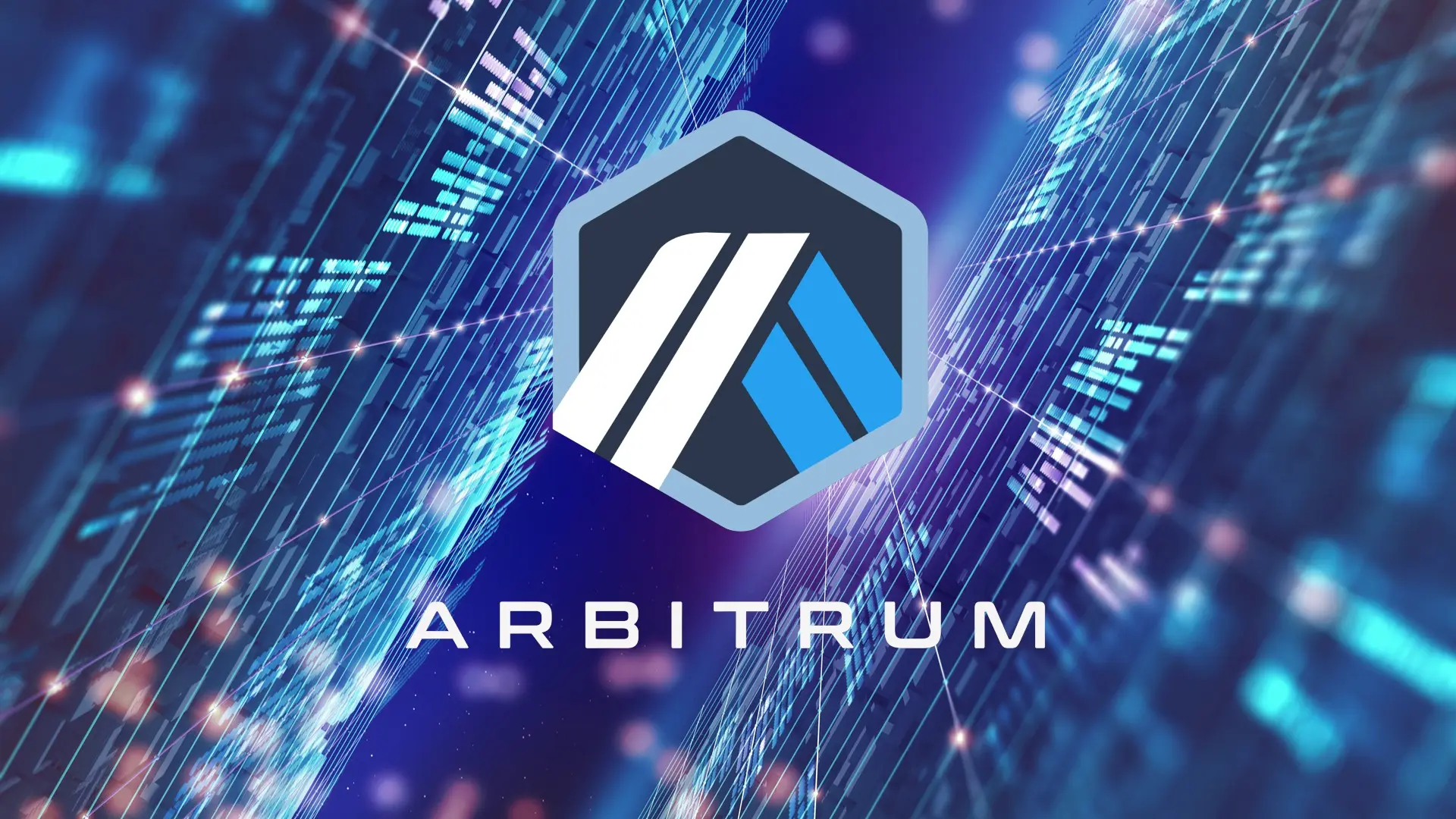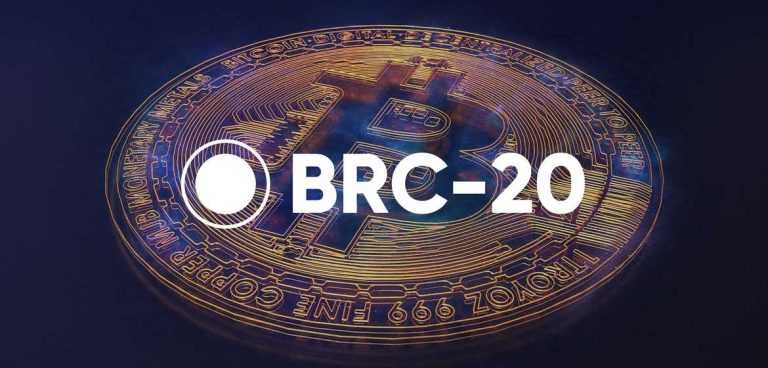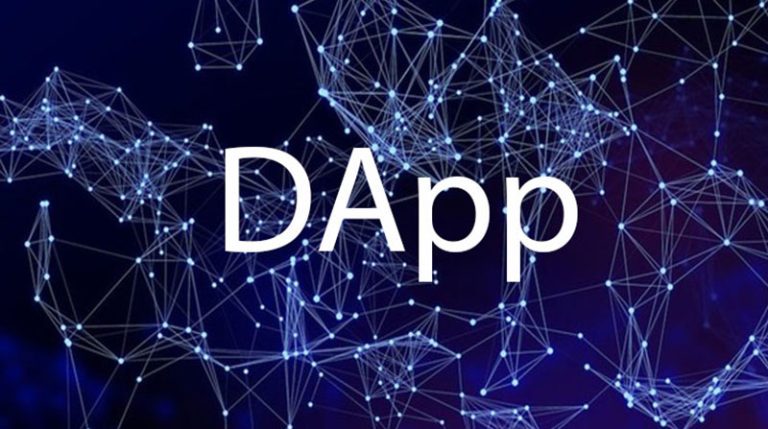Introduction
The purpose of this article is to provide an overview of Arbitrum, a project that aims to create a scalability solution for Ethereum. Arbitrum is a technology suite that enables the creation of scalable and secure decentralized applications on Ethereum, using a technique called Optimistic Rollup. Arbitrum reduces the gas costs and latency of transactions, while preserving the security and compatibility of Ethereum. In this article, we will explore the project overview, background, tokenomics, among others of Arbitrum.
Overview
Arbitrum is a technology suite that consists of three main components: Arbitrum Rollup, Arbitrum AnyTrust, and Arbitrum Orbit. Arbitrum Rollup is an Optimistic Rollup protocol that scales Ethereum by moving most of the computation and storage off-chain, while keeping the data availability and dispute resolution on-chain. Arbitrum Rollup can process thousands of transactions per second, with sub-second confirmation times, and minimal fees. Arbitrum Rollup is compatible with any Ethereum smart contract, and does not require any changes to the contract code. Arbitrum Rollup is secured by the Ethereum network, and inherits its security guarantees.
Arbitrum AnyTrust is a variant of Arbitrum Rollup that allows for the creation of permissionless and customizable chains, called AnyTrust chains, that can have their own consensus rules and parameters. AnyTrust chains are suitable for applications that require low transaction costs, such as gaming and social. AnyTrust chains are secured by a Data Availability Committee, which is a set of nodes that commit to making the chain data available on Ethereum, and can be challenged by anyone in case of fraud or censorship.
Arbitrum Orbit is a framework that allows for the creation of interconnected chains, called Orbit chains, that can settle to any Arbitrum Rollup or AnyTrust chain. Orbit chains are fully permissionless, and can have their own dedicated throughput, increased gas fee reliability, and custom features. Orbit chains can communicate and exchange value with other Orbit chains, as well as with the Ethereum mainnet, through the Arbitrum Bridge.
Arbitrum is based on a novel technique called Optimistic Rollup, which is a layer-2 scaling solution that leverages the security and decentralization of Ethereum, while improving its scalability and performance. Optimistic Rollup works by moving most of the computation and storage off-chain, to a network of validators, who execute and verify the transactions, and submit the results to Ethereum. The validators also post a bond, which can be slashed if they act dishonestly or maliciously. The transactions are assumed to be valid, unless someone submits a proof of fraud, which triggers a dispute resolution process on Ethereum. This way, Optimistic Rollup reduces the gas costs and latency of transactions, while preserving the security and compatibility of Ethereum.
Arbitrum is developed by Offchain Labs, a research and development company that focuses on building blockchain and cryptography solutions for enterprises, developers, and users. Offchain Labs was founded in 2018 by Ed Felten, Steven Goldfeder, and Harry Kalodner, who are computer science professors and researchers at Princeton University, and have extensive experience and expertise in the fields of cryptography, security, and distributed systems.
Background

Arbitrum was launched to the public in 2021, after three years of research and development. Arbitrum is named after the concept of arbitration, which is a method of resolving disputes by a third party, who is trusted by both sides. Arbitrum uses a similar mechanism, where disputes are resolved by the Ethereum network, which is trusted by both the validators and the users. Arbitrum also uses the term “rollup” to refer to the technique of aggregating and compressing transactions off-chain, and submitting them to Ethereum as a single transaction. Arbitrum’s native cryptocurrency, XAI, is named after the concept of explainable artificial intelligence, which is a branch of AI that aims to provide transparent and understandable explanations for the decisions and actions of AI systems.
Since its launch, Arbitrum has achieved several milestones, such as:
– Launching the Arbitrum One mainnet beta, the first public deployment of Arbitrum Rollup, which is open to developers and users, and supports over 400 projects, in May 2021.
– Launching the Arbitrum Nitro stack, the latest version of Arbitrum Rollup, which introduces various improvements and optimizations, such as faster transaction confirmation, lower gas costs, and higher throughput, in September 2021.
– Launching the Arbitrum Bridge, a cross-chain bridge that enables the transfer of tokens and value between Ethereum and Arbitrum, as well as between different Arbitrum chains, in September 2021.
– Launching the Arbitrum DAO, a decentralized autonomous organization that governs the Arbitrum network, and allows XAI holders to vote on proposals and changes to the protocol, in October 2021.
– Launching the Arbitrum NFT marketplace, a platform that enables the creation, buying, selling, and trading of non-fungible tokens (NFTs) on Arbitrum, and supports various digital art and collectibles, in November 2021.
Tokenomics
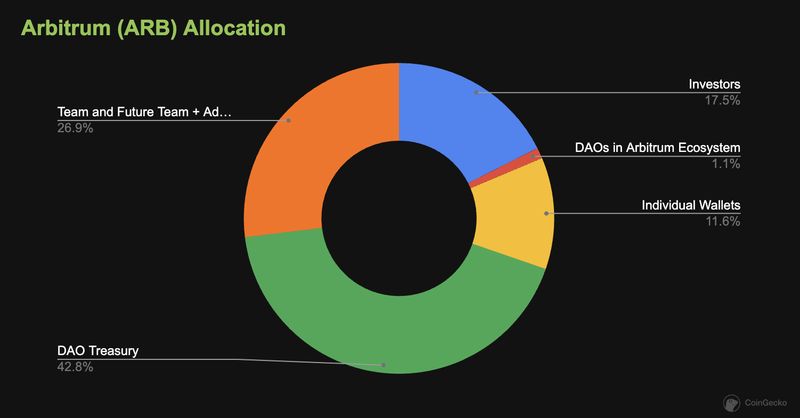
XAI is the native utility token of Arbitrum, and it is used for the following functions:
– Payment: Users can use XAI to pay for the transaction fees and gas costs on the Arbitrum network, which are determined by the validators, and depend on the complexity and demand of the transactions.
– Staking: Users can stake XAI to participate in the consensus and governance of the Arbitrum network, and earn rewards for their service. XAI holders can either run their own validator nodes, or delegate their XAI to other validator operators, who share a portion of the rewards with the delegators.
– Governance: Users can use XAI to participate in the governance and development of the Arbitrum network, by voting on proposals and changes to the protocol, and influencing the direction and vision of the project.
The total supply of XAI is 1,000,000,000 and the current circulating supply is 100,000,000 (~10% of the total token supply) as of November 12, 2023. The token distribution of XAI is as follows:
– Validators: 40% (400,000,000 XAI), allocated for the validators who provide and verify data or computation to smart contracts, and receive XAI as rewards and incentives.
– Team: 20% (200,000,000 XAI), allocated for the team members who develop and maintain the Arbitrum network, and receive XAI as compensation and vesting.
– Investors: 20% (200,000,000 XAI), sold to the public and private investors who supported the project in 2019 and 2021, at an average price of $0.05 per XAI.
– Treasury: 10% (100,000,000 XAI), reserved for the future development and operations of the project, and funded by a portion of the transaction fees and the inflation of the token supply.
– Community: 10% (100,000,000 XAI), allocated for the community members who contribute and participate in the Arbitrum ecosystem, and receive XAI as grants, airdrops, and rewards.
Users can buy, store, and trade XAI on various platforms, such as:
– Arbitrum: Users can use the official Arbitrum platform and website to access various features and functionalities of the network, such as the Arbitrum Docs, the Arbitrum Bridge, and the Arbitrum NFT marketplace.
– Uniswap: Users can swap XAI with other tokens on Uniswap, a decentralized exchange that supports Arbitrum and other Ethereum-based projects.
– SushiSwap: Users can swap XAI with other tokens on SushiSwap, a decentralized exchange that supports Arbitrum and other Ethereum-based projects.
– MetaMask: Users can store and manage XAI and other Ethereum-based tokens on MetaMask, a browser extension wallet that supports Arbitrum and other Ethereum-based projects.
– Ledger: Users can store and manage XAI and other Ethereum-based tokens on Ledger, a hardware wallet that supports Arbitrum and other Ethereum-based projects.
Arbitrum Price Stats
Market Cap: $1,433,582,596
Circulating Supply: 1,275,000,000 ARB
Supply Cap: 10,000,000,000 ARB
All Time High: $11.80 -90.32%
All Time Low: $0.9142 +24.89
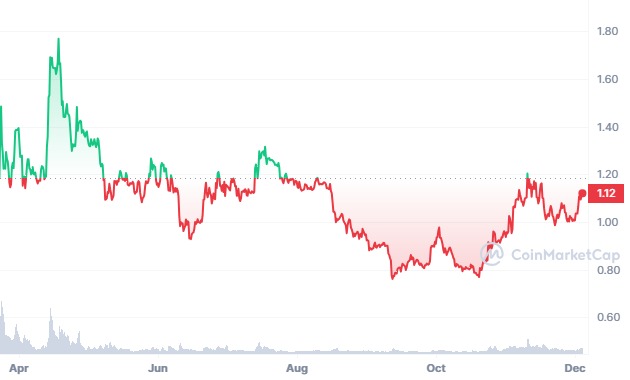
Features and Functionality
Arbitrum offers a suite of features and functionality that power the scalability and security of Ethereum, such as:
– Rollup: Users can access the Arbitrum Rollup protocol, which is an Optimistic Rollup protocol that scales Ethereum by moving most of the computation and storage off-chain, while keeping the data availability and dispute resolution on-chain. Arbitrum Rollup can process thousands of transactions per second, with sub-second confirmation times, and minimal fees. Arbitrum Rollup is compatible with any Ethereum smart contract, and does not require any changes to the contract code. Arbitrum Rollup is secured by the Ethereum network, and inherits its security guarantees.
– AnyTrust: Users can access the Arbitrum AnyTrust protocol, which is a variant of Arbitrum Rollup that allows for the creation of permissionless and customizable chains, called AnyTrust chains, that can have their own consensus rules and parameters. AnyTrust chains are suitable for applications that require low transaction costs, such as gaming and social. AnyTrust chains are secured by a Data Availability Committee, which is a set of nodes that commit to making the chain data available on Ethereum, and can be challenged by anyone in case of fraud or censorship.
– Orbit: Users can access the Arbitrum Orbit framework, which allows for the creation of interconnected chains, called Orbit chains, that can settle to any Arbitrum Rollup or AnyTrust chain. Orbit chains are fully permissionless, and can have their own dedicated throughput, increased gas fee reliability,and custom features. Orbit chains can communicate and exchange value with other Orbit chains, as well as with the Ethereum mainnet, through the Arbitrum Bridge.
Some of the unique selling points and advantages of Arbitrum are:
– Scalability and Performance: Arbitrum is a scalability and performance solution for Ethereum, where it reduces the gas costs and latency of transactions, while increasing the throughput and capacity of the network. Arbitrum can process thousands of transactions per second, with sub-second confirmation times, and minimal fees, compared to the Ethereum mainnet, which can process around 15 transactions per second, with several minutes of confirmation times, and high fees.
– Security and Compatibility: Arbitrum is a security and compatibility solution for Ethereum, where it preserves the security and decentralization of Ethereum, while improving its scalability and performance. Arbitrum is secured by the Ethereum network, and inherits its security guarantees, such as censorship resistance, immutability, and finality. Arbitrum is also compatible with any Ethereum smart contract, and does not require any changes to the contract code, making it easy and seamless for developers and users to migrate to Arbitrum.
– Flexibility and Customizability: Arbitrum is a flexibility and customizability solution for Ethereum, where it allows for the creation of permissionless and customizable chains, that can have their own consensus rules and parameters, and support various applications and use cases. Arbitrum also allows for the creation of interconnected chains, that can settle to any Arbitrum chain, and communicate and exchange value with other chains, as well as with the Ethereum mainnet, through the Arbitrum Bridge.
Roadmap and Future Developments
Arbitrum has an ambitious roadmap and vision for the future development of the project and the ecosystem. Some of the goals and objectives of Arbitrum are:
– Expanding the network of validators and users, and increasing the adoption and usage of Arbitrum Rollup, AnyTrust, and Orbit chains, and supporting various projects and applications, such as DeFi, gaming, NFTs, and more.
– Enhancing the scalability and performance of the Arbitrum network, by implementing various improvements and optimizations, such as Nitro, OCR, and CCIP, which reduce the on-chain gas costs and latency of data delivery, and increase the throughput and capacity of the network.
– Extending the functionality and utility of the Arbitrum network, by launching various products and services, such as the Arbitrum NFT marketplace, the Arbitrum DAO, the Arbitrum SDK, and more, which enable new and innovative use cases and features for smart contracts, such as NFTs, governance, development, and more.
– Collaborating with various smart contract platforms and blockchain networks, and supporting the interoperability and collaboration of various protocols and platforms, such as Ethereum, Binance Smart Chain, Polkadot, Solana, and more, through the Arbitrum Bridge and other cross-chain solutions.
– Partnering with various enterprises and organizations, and supporting the adoption and integration of Arbitrum services into various sectors and industries, such as finance, gaming, supply chain, social, and more.
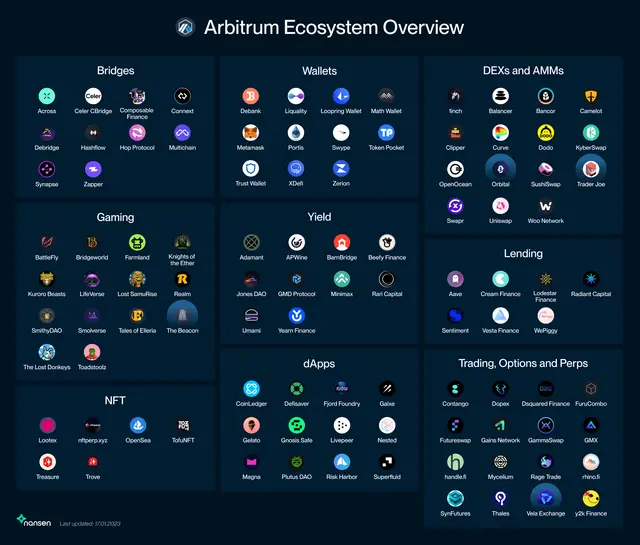
Risks and Challenges
Arbitrum faces some potential risks and challenges that may affect the project and the ecosystem, such as:
- Competition: Arbitrum competes with other layer-2 scaling solutions and platforms, such as Polygon, Optimism, zkSync, and more. Arbitrum needs to maintain its competitive edge and differentiation by offering superior scalability, performance, security, compatibility, flexibility, and customizability, and attracting more users and developers to its network.
- Adoption: Arbitrum needs to increase its adoption and usage, by creating more value and utility for its users and developers, and supporting more use cases and applications that can benefit from its network. Arbitrum also needs to overcome the network effects and switching costs that may hinder its adoption and growth.
- Regulation: Arbitrum operates in a highly uncertain and evolving regulatory environment, where different jurisdictions may have different rules and requirements for layer-2 scaling and smart contract services. Arbitrum needs to comply with the relevant laws and regulations, and avoid any legal or regulatory issues that may affect its operations and reputation.
Arbitrum addresses these challenges by:
- Innovation: Arbitrum strives to innovate and improve its features and functionality, and offer the best user experience and value proposition for its users and developers. Arbitrum also leverages the innovation and collaboration of its team and partners, who have extensive experience and expertise in the fields of cryptography, security, and distributed systems, and integrates with the latest technologies and developments in the industry.
- Education: Arbitrum strives to educate and inform its users and developers, by providing various resources and tools, such as the Arbitrum Docs, the Arbitrum Blog, the Arbitrum Discord, and more. Arbitrum also strives to educate and inform the public and the regulators, by providing various reports and publications, such as the Arbitrum Whitepaper, the Arbitrum Research, the Arbitrum Podcast, and more.
- Community: Arbitrum strives to build and nurture its community, by providing various platforms and channels, such as the Arbitrum Forum, the Arbitrum Reddit, the Arbitrum Telegram, and more. Arbitrum also strives to engage and empower its community, by providing various opportunities and incentives, such as the Arbitrum Hackathons, the Arbitrum Grants, the Arbitrum Nodes, and more.
Conclusion
Arbitrum is a technology suite that enables the creation of scalable and secure decentralized applications on Ethereum, using a technique called Optimistic Rollup. Arbitrum reduces the gas costs and latency of transactions, while preserving the security and compatibility of Ethereum. Arbitrum consists of three main components: Arbitrum Rollup, Arbitrum AnyTrust, and Arbitrum Orbit. Arbitrum Rollup is an Optimistic Rollup protocol that scales Ethereum by moving most of the computation and storage off-chain, while keeping the data availability and dispute resolution on-chain. Arbitrum AnyTrust is a variant of Arbitrum Rollup that allows for the creation of permissionless and customizable chains, that can have their own consensus rules and parameters. Arbitrum Orbit is a framework that allows for the creation of interconnected chains, that can settle to any Arbitrum Rollup or AnyTrust chain. Arbitrum is a project that is worth following and supporting, as it contributes to the scalability and security of Ethereum.
Sources
https://arbitrum.io/
https://developer.offchainlabs.com/
https://medium.com/offchainlabs
https://bridge.arbitrum.io/
https://coinmarketcap.com/currencies/arbitrum/
